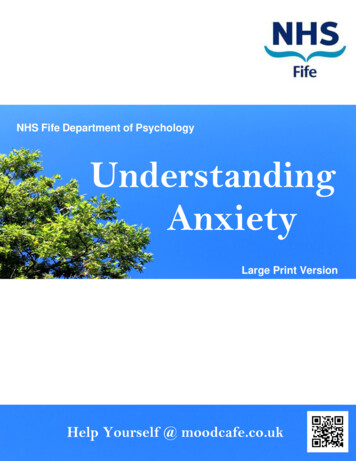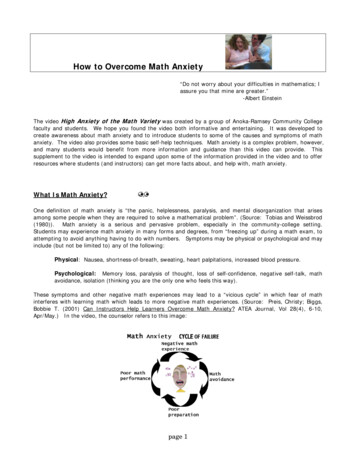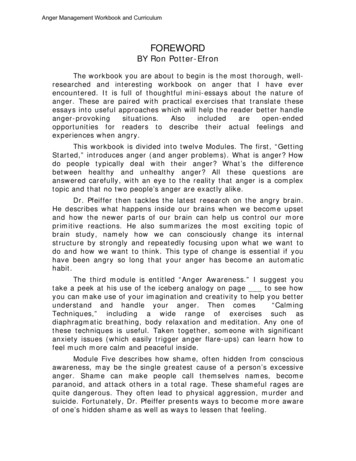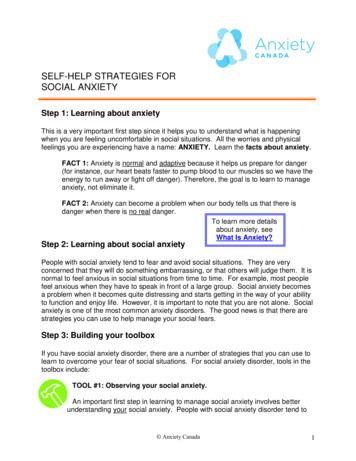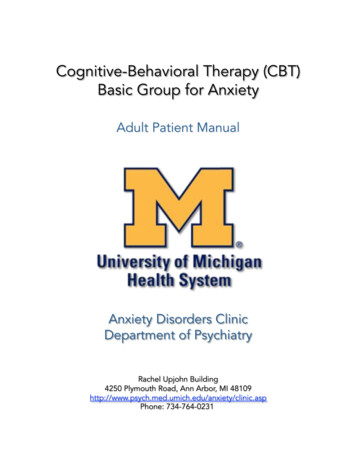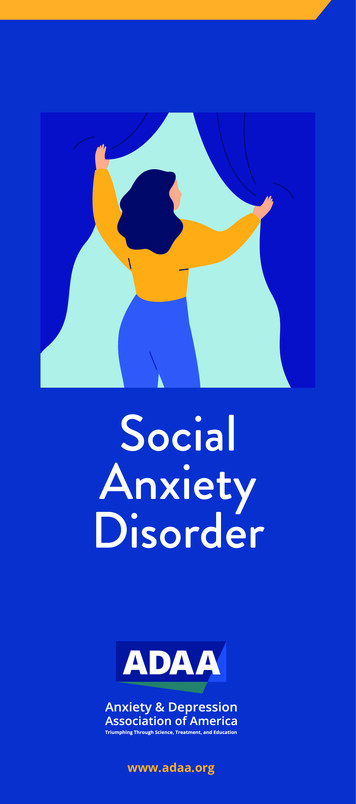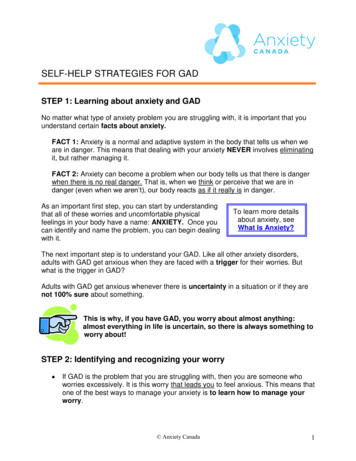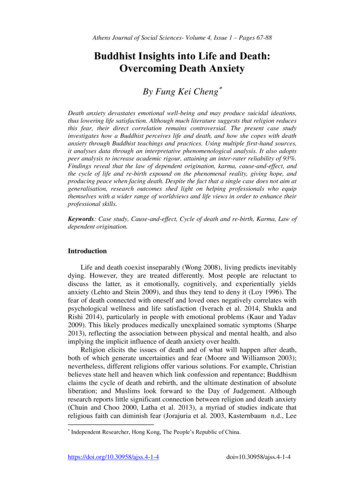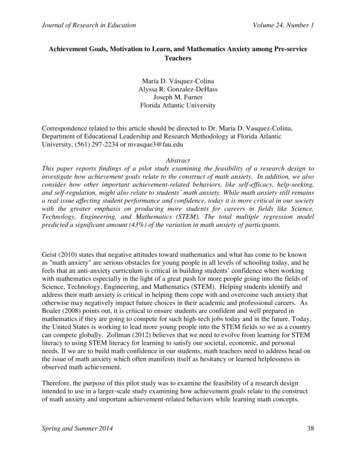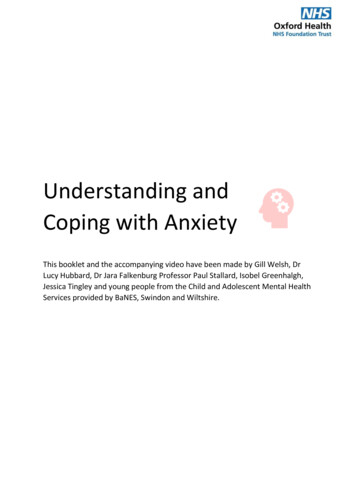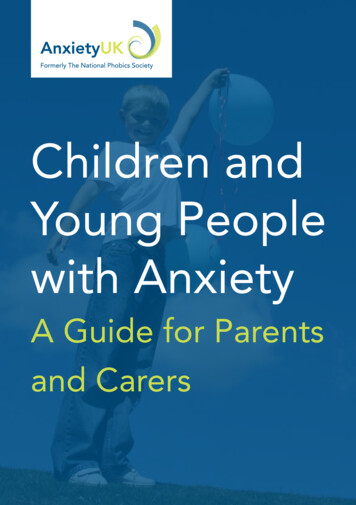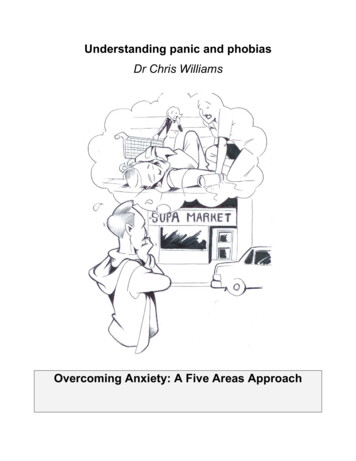
Transcription
Understanding panic and phobiasDr Chris WilliamsOvercoming Anxiety: A Five Areas Approach
2Section 1:Introduction.The workbook will cover: How to use this workbook. The key elements of anxiety, panic attacks and phobias so that you will understand howanxiety can affect you. The impact of how what you think can affect how you feel and unhelpfully alter what you do. The Five Areas of Anxiety: the situations, relationship and practical problems faced, and thealtered thinking, emotional and physical feelings and behaviour that occur as part of panic andphobias. The areas you need to tackle to overcome your own problems of anxiety, panic and phobias.Don’t be concerned if any of these words seem new or difficult to understand. All the terms will bedescribed clearly as you read through the workbook.How to use this workbook.Take time to read the workbook at your own pace. You don’t have to sit down and read it in one go.You might find it most helpful to set yourself the target of reading the workbook one section at atime. Try to answer all the questions asked. The process of having to stop, think and reflect onhow the questions might be relevant to you is crucial to getting better. Write down your own notes in the margins or in the My Notes area at the back of theworkbook to help you remember information that has been helpful. Plan to review your notesregularly so that you apply what you have learned. Once you have read through the entire workbook once, put it on one side and then re-read itagain a few days later. It may be that different parts of it become clearer, or seem more usefulon second reading. Use the workbooks to build upon the help you receive in other ways such as other helpfulreading, talking to friends, or self-help organisations and support groups. Remember that although change can seem difficult at first, it is possible.Discuss the workbook with your health care practitioner and those who give you helpful support sothat you can work together on overcoming the problems.Overcoming Anxiety Dr C J Williams (2003)
3Understanding anxiety.Anxiety, tension, stress, and panic are all terms that are used to describe what is a widespreadproblem for many people. Anxiety can affect everyone and anyone. Very high levels of anxiety andfear are described as feelings of panic.Can anxiety be helpful?Anxiety is a common and normal emotion, which can be helpful even though it can feel unpleasant.For example, at lower levels it can help motivate us to prepare for events such as interviews orexams. Anxiety is also helpful in situations of sudden danger where it helps us to respond and getaway as rapidly as possible. The problem is when we feel anxious in situations that are not dangerousat all. Another problem is feeling extremely anxious well beyond what is helpful in the circumstances.For example, being so anxious that you cannot cross the road or enter a shop.What are panic attacks and phobias?What is a panic attack?Sometimes anxiety can rise to such a high level that we feel so mentally and physically tense andunwell that we stop what we are doing and try to leave or escape the situation. Sometimes we mayfeel paralysed into inactivity like rabbits caught in the headlamps of a car and freeze, expectingdisaster to strike at any moment. This feeling of acute fear, dread or terror is called a panic attack.Panic attacks rarely last longer than 20-30 minutes.During panic, there are strong beliefs that something terrible or catastrophic is happening right now.Common fears are "I'm going to faint", "I'm going to suffocate" "I'm going to collapse", "I'm going to havea stroke", or "I'm going to have a heart attack". Sometimes the fear is of going mad or losing control.The key point is always that the fear is immediately threatening, scary and catastrophic. We becomeoverly aware of the anxiety and quickly stop what we are doing, and hurry away from the situation.Sometimes we don’t have a specific fear or anxiety. Instead, anxious worries build up and up in ourminds. Sometimes what starts as anxious worrying about difficulties can build up over time until a stateof panic develops.Overcoming Anxiety Dr C J Williams (2003)
4Panic attack checklist:Q Do I notice anxiety that rises to a peak?YesNoQ. Do I feel mentally very scared and physically unwell during the panic?YesNoQ. Do I fear that something terrible/catastrophic will happen during the panic?YesNoQ. Do I become overly aware of the things that I fear might happen during panic? YesNoQ. Am I downplaying my own ability to overcome these problems?NoYesQ. Do I stop what I am doing and try to immediately escape or leave when I feel like this?YesNoIf you have answered Yes to any of these questions, then panic may be a problem for you.How common is panic?Because people often don’t want to talk about mental health problems, you may think you are theonly person to have these difficulties. This is not true. You may be surprised to learn that about onein twenty people experience problems of panic attacks at any one time. Think of the people who livein the same street as you. There are likely to be at least one or two people in your street whocurrently have problems with panic. There will also be people who have experienced problems ofpanic in the past.Panic attacks commonly occur as part of other mental health difficulties: Depression. This often causes or worsens anxiety. Here, depressing thoughts are linked to lowmood, a lack of enjoyment and reduced activity. If you think you may be depressed then youshould talk to your health care practitioner to find out more. Generalised anxiety. Here, worries are anxiously gone over again and again in a way that isunhelpful because it does not actually help to sort out the difficulties that are being worried about.Look at the workbook Understanding worry and generalised anxiety to find out more. Obsessive-compulsive disorder. Obsessional thoughts seem senseless and unwanted. Theygo round and round your mind and focus on fears that some harm or damage may result fromsomething you have done or might do. The workbook Understanding obsessive-compulsivesymptoms (OCD) addresses this.Overcoming Anxiety Dr C J Williams (2003)
5What is a phobia?You may have friends or relatives who are very scared of animals or insects such as spiders, or ofsituations such as heights. You yourself may have such fears. Sometimes even just thinking about thefeared situation can cause strong feelings of panic. We may avoid anything to do with that situation as aresult. This can lead to an increasingly restricted lifestyle. It also undermines your confidence andcauses additional distress. When this occurs, we have a phobia. Phobias, worry, obsessive-compulsivedisorder, depression and panic attacks can occur together.Definition: A phobia describes problems of high anxiety (often with panic attacks) that regularly occursin a particular situation. In phobias, we become overly aware of any possible threats relating to ourfear and try to avoid or quickly leave any situation, people or places that cause us to feel anxious.We often know logically that the situation will not harm or kill us, yet we experience the anxiety anyway.Phobia checklist:Q. Do I notice strong feelings of anxiety or panic when I face particular situations, people or places?YesNoQ. Does even thinking about these situations/places/people make me feel nervous? YesNoQ. Have I become overly sensitive to anything to do with the phobic fear?YesNoQ. Am I downplaying my own ability to overcome these fears?YesNoQ. Am I avoiding these situations, places or people?YesNoQ. Overall, am I living an increasingly restricted lifestyle as a result?YesNoIf you have answered Yes to any of these questions, then you may have a phobiaIn the next section of the workbook, you will find out about the different sorts of phobias that can occur.Overcoming Anxiety Dr C J Williams (2003)
6Section 2:What are the different types of phobia?Remember: A phobia describes problems of high anxiety (often with panic attacks) that regularlyoccurs in a particular situation. We become overly aware of any possible threats relating to our fearand do all we can to escape. We then avoid any situation, people or places that causes us to feelanxious. We know logically that the situation will not harm or kill us, yet we experience the anxietyanyway.Virtually any situation, places or people can become the focus of a phobia. Each phobia has a specificname. This section summarises the most common types.a). Avoidance of very particular situations or objects.Almost any object can become a cause of phobic fear. For example heights and insects (e.g. wasps orspiders). This type of phobia is often called a specific phobia since exposure to this one situation/objectresults in intense fear, and causes the person to hurry away.Choice point: if you think that this sort of specific phobia may apply to you, please read the followingtext. If not, please skip to b) below.Example 1: Jane has a strong phobic fear of spiders. One afternoon, a spider scuttles across thecarpet in front of her. She immediately screams, and feels great anxiety, panic and fear. Her heartspeeds up and races in her chest. She feels very physically tense, shaky and weak. The fear not onlyaffects how she feels, but also affects how she reacts:Avoidance: Jane leaves the room by jumping onto the settee to get to the door. She then runs out andslams the door behind her.Unhelpful behaviours: Jane asks her neighbour Helen if she will take the spider well away from thehouse. She steers well clear as Helen does this. Finally, Jane repeatedly checks that Helen has reallyremoved the spider. She is ashamed she had asked Helen to do this. She can’t go back into the roomuntil she knows the spider has gone.The avoidance is unhelpful because:a). It undermines Jane’s confidence in being able to deal with the problem.Overcoming Anxiety Dr C J Williams (2003)
7b). It reinforces her belief that she can only cope by leaving the situation.In extreme form, the fear prevents the person living their life normally. They think all the time about thepossibility of coming across a spider again. Any possible situations where spiders might lurk areavoided or approached only gingerly. Even pictures of spiders are avoided.This example summarises some of the key elements of phobic anxiety. A similar situation is seen forany other feared object or situation.b). Avoidance of specific places from which escape might be difficult.You may have heard of people who have panic attacks on buses or in shops or other crowdedsituations. This is called agoraphobia. This is one of the most common forms of phobia. The termagoraphobia literally means “fear of the market place” in Greek. The term is now used to describe afocused fear of any specific place where leaving is difficult.It can include situations such as: Being on a bus, train or aeroplane where the doors are closed. It can include being given a lift in acar, or being driven through a situation where stopping would be difficult. For example drivingthrough a long tunnel or across a toll bridge. Sitting in a cinema or theatre – particularly if you are not sitting near the exit. Sitting in the middleof the row where you have to pass others to leave may also cause problems. Shopping in large (or sometimes smaller) shops, or being in long queues waiting to pay your bill. Eating in restaurants, particularly if you are some distance from the exit.The key element is that these are situations where it is either physically difficult to leave (such as a trainwhere the doors are closed), or it is socially difficult to leave (for example to leave a cinema wouldmean pushing past people to get out). The result is that the person feels trapped. They noticeincreasingly catastrophic fears about what might happen if they can’t escape from the place or situation.Choice point: if you think that agoraphobia may apply to you, please read the following text. If not,please skip to c) below.Example: Harvinder has developed panic attacks whenever he goes shopping. He has had thisdifficulty for about 6 months. He starts noticing the anxiety increasing as he plans his weekly shop. Onthe way to the supermarket he is very aware of his heart thumping. His breathing is faster than usual.Overcoming Anxiety Dr C J Williams (2003)
8As he enters the store his breathing speeds right up and his heart starts racing. He fears that he willpass out and collapse. As he breaths faster and faster he feels even dizzier. Harvinder changes hisbehaviour to try to make himself feel better.He does this in two ways: Avoidance: Over recent months Harvinder has tended to stop going to supermarkets. He nowonly rarely visits them and shops at quieter times. Unhelpful behaviours: He walks faster than usual as he shops. He also holds tightly to theshopping trolley for support. On previous occasions he has persevered and reached thecheckouts. He has previously always chosen the till with the shortest queue and had his moneyready for a quick escape. Today however he tries to control his breathing by taking rapid breaths.This makes things worse. After only five minutes he abandons the trolley in the middle of thestore and walks/runs outside. He sits on a seat outside to recover. He decides next time he willbring someone along with him in case he feels like this again. He pledges that he will never goback into another supermarket.Harvinder’s panicky fears have affected how he feels emotionally and physically. They have alsounhelpfully altered what he does. His altered behaviour succeeds in helping him feel safer in the shortterm. However in the longer-term this action backfires and further undermines his confidence. Leavingthe shop quickly reinforced the underlying beliefs that he can only cope by leaving an anxiety-provokingsituation. It prevents him from staying in the store. Staying in the store would have allowed him to testout if his fear of fainting/collapsing would really happen.c). Avoidance of conversations with people/being in the spotlight.A degree of shyness affects many people. A social phobia occurs where there is an excessive shynessand a very strong fear that others are judging us negatively. This extreme form of shyness affects aboutone person in 35 at some stage in their lives.Social phobia causes great difficulty in one to one situations or whenever the person thinks that thespotlight is on them. For example meeting new people, or making small talk over coffee can bedesperately difficult. Situations such as this lead to mind-reading that others don’t like us, or judge us tobe unattractive, boring, inferior or stupid. These thoughts lead to symptoms of strong anxiety.Overcoming Anxiety Dr C J Williams (2003)
9Other situations that people might find difficult include times when others are watching them perform atask, such as giving a talk or doing karaoke. Here the fear is focused on public speaking to a largergroup of people. For example a teacher can become very anxious leading a class. Any other situationwhere the person is the centre of attention can cause similar symptoms.Sometimes, the person with social phobia starts to drink far more than usual to help them cope withsocial situations. This can lead to drink problems and alcohol dependency.Overcoming Anxiety Dr C J Williams (2003)
10Choice point: if you think that social phobia may apply to you, read the following text. If not, pleaseskip to the next section of the workbook.Example: Dawn becomes very anxious in social situations. This has worsened since she was ateenager when she had bad acne. Even though the acne has now cleared her anxiety in socialsituations has got worse and worse. During these occasions she notices strong bodily symptoms ofanxiety. She feels hot and flushed, sweaty and slightly shaky. She is very aware of her dry mouth andnotices a frog in her throat. She is overly sensitive to these physical symptoms, She constantly predictsthat the person she is speaking to will be aware of her discomfort and judge her negatively.To try to cover these symptoms up she alters what she does by: Avoidance. Dawn chooses to avoid social situations where possible. She tends to say no toinvitations to meals out or parties, and tries to keep all social encounters as short as possible. Unhelpful behaviours. Dawn tries to avoid eye contact with people. She only makes eye contactbriefly and for as short time as possible. She finds herself constantly tempted to cut conversationsshort and leave abruptly. She is especially aware of feeling hot, flushed and sweaty and uses herhandkerchief to repeatedly dab her forehead. She also tries to cool down by fanning herself withher hand and by blowing air from her mouth directed up at her forehead. Finally, she keepsswallowing hard and coughing to try to clear her throat.Here again, what Dawn thinks affects how she feels emotionally and physically, and can alsounhelpfully alters what she does. The altered behaviour is designed to help Dawn cope with the anxietyof social contact. However her actions and avoidance can backfire and undermine her confidence evenmore. Hurrying away will reinforce her underlying beliefs that she can only cope by leaving a situation.Mopping her brow reinforces the fears that others will have judged her negatively because she is overlyaware that she has acted differently to the people around her. Finally, the actions she takes mightactually draw more attention as a result. This is quite the opposite of what she wished.Overcoming Anxiety Dr C J Williams (2003)
11Section 3:Understanding panic and phobias: My own Five Areas Assessment.A Five Areas Assessment can be helpful in understanding your own symptoms of anxiety, and inchoosing targets to change how you feel.The five areas are:1. Life situation, relationships, practical problems and difficulties (e.g. problems at home or work).2. Altered thinking (with extreme and unhelpful thinking)3. Altered feelings (also called moods or emotions).4. Altered physical symptoms/feelings in the body.5. Altered behaviour or activity levels (with avoidance, or unhelpful behaviours).The Five Areas Assessment indicates that what a person thinks about a situation or problem may affecthow they feel emotionally and physically, and also alters what they do. Look at the arrows in thediagram. Each of these five areas affects the others and offers possible areas of change to reduceanxiety.The Five Areas Assessment.Life situation/ relationship orpractical problemsAltered thinkingAltered physicalsymptomsAltered feelingsAltered behaviourOvercoming Anxiety Dr C J Williams (2003)
12A key point is that what we think about a situation affects how we feel physically and emotionally. Italso affects what we do. You will now have the chance to consider how this approach can help youunderstand your own anxiety.Key point: As you go through the five areas assessment, please think about how anxiety hasaffected you in the last week. Try to answer all the questions and really think about how they applyto you. By doing this you will be able to identify possible target areas for change.In order to break down the task, the first four of the five areas will be covered in this section. Thefinal area, altered behaviour will be covered in the next section.Area 1: Situation, relationship and practical problems.All of us from time to time face practical problems or difficulties in relationships. When we face alarge number of problems we may begin to feel overwhelmed. Difficult situations include everydayevents such as comments from family, friends or others that we take personally.Practical problems may include: Debts, housing or other difficulties. Problems in relationships with family, friends or colleagues etc. Other difficult situations that you face such as problems at home or work (or lack of work - forexample unemployment).The following table summarises several common factors that may be associated with anxiety. Areany of these relevant to you?Situation, relationship and practical problems.I have relationship difficulties (such as arguments).YesNoI can’t really talk and receive support from my partner.YesNoThere is no one around who I can really talk to.YesNoMy children won’t do what I tell them.YesNoI have difficulties with money problems or debts.YesNoThere are problems with my flat/house.YesNoI am having problems with my neighbours.YesNoI don’t have a job.YesNoOvercoming Anxiety Dr C J Williams (2003)
13I have difficulties with colleagues at work.YesNoYou may notice that different situations, places or people also seem to worsen your anxiety. Writethese here:You will find out more about these as you complete your own five areas assessment.Summary for Area 1: Situation, relationship and practical problems.Having answered these questions:Q. Overall, do I have any problems in this area?YesNoThese difficulties are potential targets for change. You will find out more about what steps to take totackle these in section 5 of the workbook.Area 2: Altered thinking in panic and phobias.Thinking can alter in various ways when panic or phobias occur.a). The unhelpful thinking styles.During panic, there are strong fears that something terrible or catastrophic is happening right now.You may jump to the very worst conclusion (catastrophic thinking) that things will go very badlywrong. Common fears are "I'm going to faint", "I'm going to suffocate" "I'm going to collapse", "I'm goingto have a stroke", or "I'm going to have a heart attack". You may fear that you are going mad or arelosing control. You may overlook your own strengths and be very self-critical. You may be prone tomind read and second-guess that others think negatively of you and rarely check out whether thesefears are true. Overall, your thinking becomes extreme, unhelpful and out of all proportion. By focusingon problems that are taken out of all proportion, your own strengths and ability to cope are overlookedor downplayed. Things are seen as being out of control.Overcoming Anxiety Dr C J Williams (2003)
14Key point: All these unhelpful thinking styles occur in each of us from time to time. However duringtimes of high anxiety they become more frequent and are harder to dismiss from the mind.Now, think about your own thinking over the last week:My anxious thinking.Q1. Am I being my own worst critic?YesNoYesNoYesNoYesNo(bias against myself)Q2. Am I focusing on the bad in situations?(putting a negative slant on things – a negative mental filter)Q3. Am I making negative predictions about the future?(make negative predictions)Q4. Am I jumping to the very worst conclusion (catastrophic thinking)?Q5. Am I second-guessing that others think badly of me without actually checking? (mind-reading)YesNoQ6. Am I taking unfair responsibility for things that aren’t really my fault? YesNo(bearing all responsibility/taking all the blame)Q7. Do I have unhelpfully high standards and use the words “should, must, ought and got to” a lot, ormake statements such as “Just typical” when something goes wrong (Unhelpfully high standards/rules)YesNoIf you have answered yes to the question about catastrophic thinking, try to identify what sort ofthoughts pop into your mind when you feel panicky.Common catastrophic thoughts during panic:Catastrophic thought.Tick here if you notice this thought."I'm going to faint or collapse/pass out”."I'm going to suffocate"."I'm going to collapse"."I'm going to have a stroke"."I'm going to have a heart attack".I’m going to go mad”.“I’m going to lose control”.“I’m going to show myself up/make a fool of myself”.Overcoming Anxiety Dr C J Williams (2003)
15Write any other catastrophic fears you have here: Why are these unhelpful thinking styles so unhelpful?These extreme thinking styles are called unhelpful because believing them worsens how we feeland unhelpfully alters what we do.Anxious thoughtsFeel more anxious.Anxious thoughtsAct in ways that worsen how you feel.Think about a recent time when you have felt more anxious or panicky. Were any unhelpful thinkingstyles present? Did they have an impact on how you felt and what you did at the time?Read the table below to find more about the links between situations, thoughts, feelings andbehaviour.Overcoming Anxiety Dr C J Williams (2003)
16Situation,relationship orpracticalproblem.1). Jane is sittingin her main roomwhen suddenly aspider runs acrossthe carpet.Immediatecatastrophising.Unhelpfulthinking style(s).Emotionaland/orphysicalimpact.Anxiety andfeel physicallytense.“It’s horrible,it will bite me.I can’t dealwith this.”Catastrophicthinking andbias againstyourself.2). Harvinder hashad fears of goingshopping for over6 months andthese are graduallygetting worse. Heis now in themiddle of a longqueue at thesupermarket.“I’m going tocollapse andpass out”.Catastrophicthinking.Anxiety andphysicalsymptoms of afaster heartrate and rapidbreathing.3). Dawn issomeone withstrong socialanxiety. She hasjust beenintroduced to anattractive stranger.“He thinksI’m boringandunattractive”.Mind-reading secondguessing thatothers don’tlike her.Anxiety andphysicalsymptomsincluding goingred and feelinghot, sweatyand shaky.Notices a drymouth and afrog in herthroat.Behaviour change.Avoidance: Jumps ontothe settee and runs away.Unhelpful behaviours:Asks neighbour to removethe spider, and repeatedlychecks that she has doneso.Avoidance: tending toavoid supermarkets, andonly shops when it isquieter.Unhelpful behaviours:Walks round the storefaster than usual, grippingtightly to the trolley.Abandons the trolley andquickly leaves the store tosit down.Avoidance: She isgenerally avoidingspeaking to peopleresulting in social isolation.Saying no to invitations out.Unhelpful behaviours:Dawn avoids eye contactas she talks. She bringsconversations to an abruptend. She is clearing herthroat and swallowing toexcess.The unhelpful thinking styles can therefore worsen how you feel emotionally and physically, andunhelpfully alter what you do in both the short and the longer-term.Other thinking changes also occur in anxiety.b). Becoming overly aware of things that seem scary.High anxiety causes us to watch out for anything that is particularly scary to us. This can include difficultsituations such as going into shops, seeing a spider, or the reactions of other people.Overcoming Anxiety Dr C J Williams (2003)
17You may be overly aware of: Scary thoughts: (e.g. that you might die), and try very hard not to think this. Scary physical symptoms in our body. During times of high anxiety, all sorts of physicalsymptoms occur. This is a standard bodily response in times of threat or danger. Your heart rateand breathing both speed up. This allows more blood to get to your muscles to defend yourself orrun away. These intense physical reactions can reinforce underlying fears that something terribleis about to happen. You will find out more about this later in this workbook.c). Images and mental pictures – an important part of anxiety.Another way that we think is often as a mental picture. Some people (although not everyone) noticemental pictures or images in their mind when they become anxious. Images are a form of thoughtand may be “still” images (like a photograph), or are moving (like a video). Images may be in blackand white or be in colour. They may include a mental picture of some catastrophic event occurringsuch as collapsing, suffocating, or of your own funeral. As with all extreme and unhelpful fears, theimages add to feelings of anxiety.Summary for Area 2: Altered thinking.Having answered the questions in this workbook about altered thinking:Q. Overall, do I have any problems in this area?YesNoThese difficulties are potential targets for change. You will find out more about what steps to take totackle these in section 5 of the workbook.Area 3: Altered feelings in anxiety.In times of high anxiety and panic, the following are common altered emotional feelings:Anxiety (also often called words like “stress” or “tension”).In anxiety, the person feels troubled, unsettled and uneasy in himself or herself. At high levels ofanxiety this can reach the level of intense fear seen in panic. Such high levels of anxiety areunpleasant but not dangerous.Overcoming Anxiety Dr C J Williams (2003)
18Anger or irritability.Little things that normally wouldn’t bother you may now seem to really irritate or upset you. Angertends to happen when you, or someone else, break a rule that you think is important, or acts tothreaten or frustrate you in some way.Shame.Feelings of shame occur when you see yourself as having undesirable qualities which if revealed toothers will result in ridicule and humiliation. For example this might be of your: Physical appearance (e.g. how your nose, ears, face, bottom, breasts etc appear to others). Emotions (e.g. shame at being anxious). Personality (e.g. that you are not confident in everything you do), or Actions (e.g. that you lied and avoided going to the party because of anxiety).These concerns lead to behaviours to hide these perceived “faults” from others.Low mood.Depression may occur at the same time as panic or phobias. It can either start or worsen symptomsof anxiety. Common terms that people use to describe low mood include depression, or feelinglow/sad/blue/upset/down/miserable or fed up. Typically in severe depression the person feelsexcessively down and few if any things cheer them up. If you feel like this, speak to your health carepractitioner.My altered feelings.Q. Do I feel very anxious or fearful/panicky at times?YesNoQ. Do I get easily angry, frustrated or more irritable than previously? YesNoQ. Do I feel shame about aspects of my actions or myself?NoYesQ. Am I feeling depressed, upset or low in mood and no longer enjoy things as before?YesNoSummary for Area 3: Altered feelings/emotions.Having answered these questions:Q. Overall
The workbook will cover: How to use this workbook. The key elements of anxiety, panic attacks and phobias so that you will understand how anxiety can affect you. The impact of how what you think c
